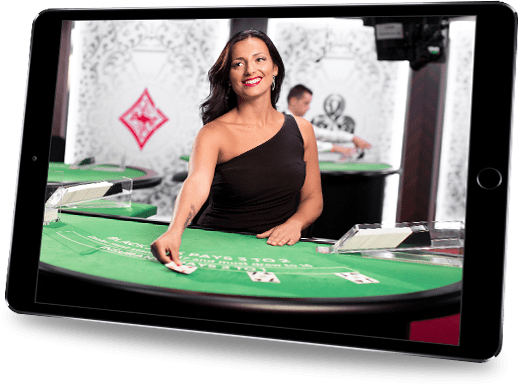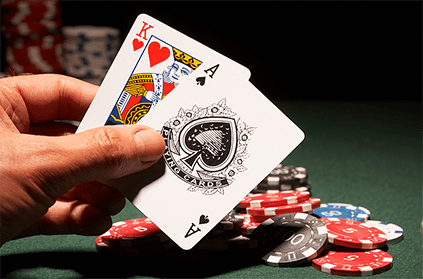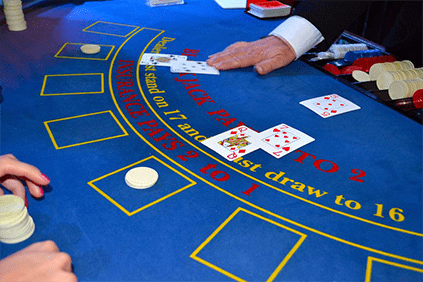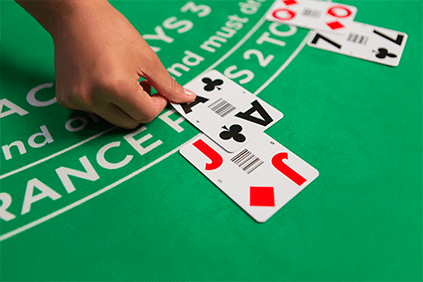

How to Play Blackjack
Blackjack is an iconic casino game that is played the world over, both in land-based casinos and online. The game is just about as old as other classic casino games like roulette or baccarat and popular for a number of reasons. For one, blackjack is known as the card game with the lowest house advantage at around 1.5%, although with proper play and a solid blackjack strategy, this can be reduced even further to as little as 0.5%.
Blackjack has the reputation of being a game that gives every player a realistic chance of having a positive outcome, provided that they take the time to learn how to play the game properly of course. At Play UK, we feature some of the very best online blackjack UK games currently available, sourced from our top software partners including Nektan, Realistic Games and NetEnt, providing the best in virtual blackjack games, and Evolution, offering you incredibly exciting and realistic live blackjack games.
With the exception of live games, all of our blackjack games can be played for real cash or for free in a demo version. This gives you the perfect opportunity to try out different styles and configurations of the game without spending any of your own cash in the process. It’s also a great way to experiment with different blackjack strategies and test out your own ideas of how to bet smart to be victorious. If you’re new to the game, Play UK is your best bet at finding the perfect game for your style, budget and preferences. Our concise and in-depth guide will teach you everything that you need to know about how to play blackjack successfully!

GETTING TO KNOW RULES OF BLACKJACK

The quickest way to learn how to play blackjack is to know and understand how blackjack rules work from a practical point. Once you understand what the rules are, you can move on to learning how the game unfolds, from sitting at the tables (virtually or otherwise) and getting your first set of two cards, to making those critical decisions that could end the round in your favour. This is where using a basic strategy for blackjack can make all the difference to your game. Adopting a strategy into your game is invaluable as it can guide you to the best decision for every two card hand that you might get during a game. But let’s first start with the basic rules of the game.
BASIC RULES OF BLACKJACK EXPLAINED
The game of blackjack is played with a standard 52-card deck, with the only difference being the number of decks used in a game. This all depends on the type of game, as some games will use only a single deck, while other games will usually use either six or eight decks. Games that use multiple decks will shuffle all of them together, giving them a much wider spread of what could come out of the shoe during each deal. The shoe is the box which holds all of those decks and allows the dealer, also known as the ‘house’ (casino), to slide a single card at a time, face down, out before dealing to each player around the table.
BLACKJACK CARD VALUES
Each card denomination in the deck is assigned a certain point value, which makes it easy to work out the value of each hand at a glance.
- Cards 2 – 10 = Their face value (a 2 is worth 2, 3 is worth 3 etc)
- Kings, Queens, Jacks = 10
- Ace cards = 1 or 11
THE OBJECTIVE OF BLACKJACK
The objective is really twofold.
- One objective is to beat the house (the casino) by ensuring that you do not end up with a hand value that exceeds a total of 21.
- The other objective is to always have a higher scoring hand than the house at the end of the round.
- Unlike other games such as poker, blackjack is not played against other players. Instead, players are playing for themselves against the casino.
How Blackjack Winning Hands are Paid Out
The best possible hand is a two-card total of 21, known as a blackjack. A blackjack hand pays out at odds of 3:2. So for example, if you had a £5 bet on the table and got a two-card blackjack over the casino, you would be paid out £7.50. This is higher than other wins which pay out a 1:1 or even money, meaning that your £5 wager would get you £5. However if the house has a two card total of 21 as well, then the hand is a tie, known in blackjack as a ‘push’, meaning that you get your original wager back. If the house draws a hand value of 21, but only manages to do so in three or more cards, the round is still yours with your two card blackjack and you will still get your 3:2 pay out.


The Blackjack Table Layout
Whether you happen to be playing in a brick and mortar casino or online with our virtual or live games, the table layout will be more or less the same. The table is semi-circular, with the operator on the inside of the semi-circle and the player positions marked out on the outside.
Depending on the game, up to seven players positions will be marked out around the table. The centre of the table will be printed with additional details of the game rules including that a blackjack pays out at 3:2, as well as certain operator rules such as: “dealer must draw to 16 & stand on 17” as well as “Insurance, pays 2 to 1”. This is something that you will see on a number of our virtual blackjack games.
To the right of the table (on your screen) the shoe is positioned, allowing the live operator or virtual program to deal cards in a clockwise fashion around the table. Depending on the game being played, the shoe can contain anything from four, six or eight decks of cards, all shuffled together. Each player position is marked with a square in which cards are placed, with an additional square available when splitting is required.
Rules of Blackjack: Betting Options and How to Play
To begin a game of blackjack, you will need to place your wager on the table. Both virtual and live games at Play UK make this process as simple as possible. You can select your chip value simply by clicking on the Bet button. Chip values range from as little as 0.50 and move up in increments including 1, 5, 25, and 100 (depending on the game). Once you’ve chosen a chip value by clicking on it, you will notice that the chip is now on the table. Your next option is to click on the ‘deal’ button, at which point you will have two cards dealt to your position, face up in your demarcated box. The house then deals two cards to their position, one will be face up so all players can see it, and one will be face down (called a hole card) and will only be turned over once all players have finished betting. Once you’ve received your first two cards you will have several betting options available to you, depending on the combined value of your two cards, as follows:
Hit
Once you’ve added the value of your first two cards together, you can ask for additional cards by clicking on the “Hit” button. This is the ideal decision if you feel that the combined value of your two cards is too low to compete with the house’s potential hand, based on the value of their face up card. You will then receive another card from the shoe, which you can then add to your total. If your total is still too low to compete, you can click on the hit button to receive another card. This option is available as many times as needed until the desired total is reached. However, if you exceed a total of 21 you will automatically lose, known in blackjack as a “bust”.


Stand
If you feel that your initial two-card value is sufficient to potentially beat the house, or if you have clicked on the hit button and have reached a satisfactory total, you can click on the “Stand” button. This indicates that you have completed your playing options and are now ready for the final part of the game.
Split
This is an excellent option if your first two cards happen to be of the same value, for example: two 8’s, two aces and so forth. This option allows you to split your two cards into separate bets, with your second card now receiving its own bet. The second bet value is the same as your first as it now becomes an entirely separate bet, complete with its own set of betting options. Each card can now receive additional cards (hit), or be left as is. In some games, if you receive another card, which also happens to be of the same value, you can split again.


Double
Also known as “Doubling Down”, this betting option allows you to double your original wager and, at the same time, receive an additional card, making a three-card hand. Depending on the game, you may double down on any two-card value, or only on two card values of 10 or 11.
Insurance
Insurance is a special betting option, which allows you to take ‘insurance’ if the house’s face up card is an ace. Insurance can be seen as a type of wager, which says that the face down card is a ten-value card, which will give the house a blackjack. This option pays out at 2:1 and may be taken for half the value of the original bet. Now, if this bet goes your way, meaning that the house does, in fact, have blackjack, you will effectively lose your hand but still come out even.
Here’s an example:
- You have your chips on table worth£10 (your hand is valued at 19 in this example)
- The house face up card is an ace card
- You decide to take insurance to the value of £5 (half the value of your original wager)
- The house does indeed have blackjack
- You lose your hand automatically (lose £10)
- You win £10 thanks to your £5 insurance bet, which pays out at 2:1 (£5x2-£10)
- Net result - You break even for that round
Should You Take Insurance?
As soon as the house shows an ace up card, the game is designed to ask if you would like to take insurance before continuing with your play. With live games, this option may be verbally communicated to you. On paper, taking insurance would be an even bet if the house’s up card showed an ace 33.3% of the time. However, in reality, only 30.8% of the cards in a deck are ten value cards. In other words, unless you happen to be good at counting cards and have a good idea whether there remains a good percentage of ten value cards still in play, taking insurance is generally a bad percentage play.
Basic Blackjack Operator Rules
After all players at the table have been dealt their two cards, and have all played according to their own needs based on the house’s face up card, the house then needs to play based on certain specific rules. In most games, the operator must draw cards up to a total of 16 or less and must stand on any total of 17 or more. Depending on the game, the operator may also draw to a ‘soft’ 17. This term is used to describe card totals that include an ace card, for example: ace/6, ace/4/2, ace/3/3 and so forth.
Variations in Rules and How it Affects House Edge Percentages
There are a lot of different blackjack games now available to players, which take the original set of basic rules and expand on them in different ways. Some blackjack games will benefit the house to a certain degree, while other games will benefit the player to a certain degree. The key to playing great blackjack is to reduce any disadvantage that you may have in the game as much as possible. Let’s take a look at some of the more common variations found in blackjack games and how they affect the house.
Doubling down after splitting – Doubling down after splitting can reduce a house benefit by as much as 0.13%, which may not seem like a lot but over the long game, it can be quite a benefit to the player.
Re-splitting ace cards – Most blackjack games only permit one additional card on each bet when splitting ace cards. However, some games will allow you to re-split if that second card happens to be another ace. This betting option will allow an additional reduction in the house benefit percentage by as much as 0.03%.
Early Surrender – The Surrender option has to do with when the house’s face up card happens to be an ace and the operator checks to see if their face down card is a ten-value card, which would make an automatic blackjack hand. Early Surrender allows the player to half of their original wager before the operator checks for blackjack. This option will further reduce the house benefit percentage by 0.624%.
Late Surrender – Late surrender is far more common in blackjack than early surrender and allows the player to take the surrender option after the operator has checked for blackjack. Late surrender reduces the house benefit by 0.02% in a single deck game, and by 0.07% in multiple deck games.
Double down only on a hard 10 or 11 hand – Some blackjack games will limit when you can double down and only allow the option on two cards that equal a hard 10 or hard 11, slightly increasing the house benefit to 0.28%
How to Use a Basic Strategy for Blackjack
You may have already come across this term ‘blackjack strategy’ while researching the game online and wondered what on earth it was all about. There are a lot of different strategies available online for games like blackjack, roulette, baccarat and poker. However, not all of these strategies are practical and not all of them will actually help your game in the long run.
Basic blackjack strategy, on the other hand, is a very practical strategy that any player can use to improve their game and it is simple and easy to implement. One of the biggest benefits of basic blackjack strategy is that even novice players can implement it right away, instantly improving your game. Using this strategy will also take your game from a mere chance like online slots, and transform it into a true game of skill.

What is Basic Blackjack Strategy?
Some years ago, experts decided to take millions of blackjack scenarios and run them through highly sophisticated computer software programs. The computer software was able to generate millions of combinations, allowing the experimentation of various responses to every two-card hand based on the house’s single face up card value. Various responses including when to hit, when to stand, when to double down and when to split were developed into a solid blackjack strategy that is now used by millions of players around the world.
Can Using Blackjack Strategy Really Improve Your Game?

Having access to information that gives you a clear guide in how to respond to various scenarios can definitely improve your overall game and can also help you to reduce the house benefit in any blackjack game. For example, in a six-deck game, using a strategy can take the house edge down to around 0.05%. While in a single deck blackjack game where the house must stand on all 17s, the player may double down after splitting; using a strategy can actually gain a benefit over the house of as much as 0.1%.
Blackjack Strategy Basics versus Other Simple Blackjack Strategies
If one were to compare a player who adopts a basic blackjack strategy versus a player that adopts some other simple game strategy, the beneficial difference is quite drastic. For example, a player who uses a strategy that dictates that they always stand on any hand to the value of 12 or higher, or a player that uses the house rule of always hitting on 16 or less and standing on 17, the house benefit percentage is around 5%. In other words, the player that uses a blackjack strategy enjoys a benefit that can be as high as ten times that of other simple strategies such as the ones mentioned here.
Benefits of Blackjack Strategy
Blackjack strategy is effective because it allows you to benefit from the fact that the house has at least one card in plain sight. If both cards were face down then the game would be much more difficult. However, since you are able to see at least one card, this gives you a bit of a head start because you can make a more informed estimation as to what the hand could end up being. This then gives you the opportunity to make a better decision regarding your own hand and its possible outcome. Let’s look at some potential examples to further illustrate this dynamic.
If the house’s face down is a ten value card, which is more than likely given the fact that ten value cards such as jacks, queens, kings and tens, make up four out of the thirteen total values found in a deck of cards. In other words, a ten-value card is the most likely value that the face down card could be in most situations. So, knowing this, if you had a two-card total of 16 and the house’s face up card was a 7, it would be a good guess that the house’s hand would total 17. This would obviously beat your hand of 16, which means that your next move would be to hit.


In another example, if the house’s face up card was a 6, and you assumed that the face down card was a ten value card, the house would be holding a hand of 16, which means that they would have to hit. This would create the best chance that the house would bust on that hand, which means that your move should be to stand on your hand of 16 (versus the house’s face up card of 6).
The above two potential scenarios are of course somewhat oversimplified for the sake of illustration but still more likely than not. When it comes to knowing when to hit, stand on hard totals, that is, two cards that do not contain an ace as an 11, using basic strategy to guide you in response to each potential hard total hand would look like this chart:
Here’s something important to note about a total of 16, one of the most common wrong decisions among blackjack players. Most players make the mistake of standing on a 16, without really taking into account what the house is showing with its up card. However, it is a mistake to do this since the house will almost always get to 17 or higher (around 80% of the time) so standing on a total of 16 is suicide. While it may seem riskier to actually hit on a 16 total hand, the fact that you will more often than not be beaten by the house draw should motivate you to hit rather than stand in this situation.
Now that you have a much clearer understanding of what to do with hard totals, soft totals can be even more of a challenge. Most players find soft totals (combos that include an 11) confusing since the ace (which counts as a 1 or an 11) seems to be the reason for some players not knowing what their next move should be. Here’s the thing with a soft 15 or a soft 16, there is no way that you could jeopardise your current hand. Just like with a hard hand total, soft hand totals also have their own set of responses for each potential scenario.

Which Matching First Two Cards Should You Split?
Splitting can be another one of those betting options that cause a fair bit of confusion with players. Despite what you may have heard, not all matching first two cards should be split. Some like ace cards and 8’s work better than others. To eliminate any confusion regarding when to split and when to keep your two-card hand together, here’s a handy chart on splitting.

Some Final Thoughts on Learning How To Play Blackjack
Now that you have learned how the game works, how the cards are valued and how to employ a strategy, it’s time to put your newfound skills to the test. At Play UK we offer a wide range of great blackjack table games including European and live dealer. Both of these are excellent and it really boils down to what sort of playing environment you are after.
Some players prefer the solitude of virtual blackjack and enjoy playing against a computer, while others prefer the atmosphere that can only be enjoyed with our live dealer games from Evolution Gaming. Either way, be sure to check out our latest bonus offers if you are signing up for the first time, or see what’s on offer if you are already a member of Play UK. Remember, you can try any of our virtual games for free in our demo mode versions. Our free blackjack games give you a great opportunity to try different styles of the game whilst at the same time putting into practice some of the great strategies that you’ve learned about in this guide.










